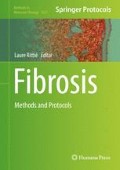Abstract
Pulmonary diseases such as fibrosis are characterized by structural abnormalities that lead to impairment of proper lung function. Stereological analysis of serial tissue sections allows detection and quantitation of subtle changes in lung architecture. Here, we describe a stereology-based method of assessing pathology-induced changes in lung structure.
Access this chapter
Tax calculation will be finalised at checkout
Purchases are for personal use only
References
Weibel ER (2013) It takes more than cells to make a good lung. Am J Respir Crit Care Med 187(4):342–346. doi:10.1164/rccm.201212-2260OE
Hsia CC, Hyde DM, Ochs M et al (2010) An official research policy statement of the American Thoracic Society/European Respiratory Society: standards for quantitative assessment of lung structure. Am J Respir Crit Care Med 181(4):394–418. doi:10.1164/rccm.200809-1522ST
Ferrando RE, Nyengaard JR, Hays SR et al (2003) Applying stereology to measure thickness of the basement membrane zone in bronchial biopsy specimens. J Allergy Clin Immunol 112(6):1243–1245
Tschanz SA, Salm LA, Roth-Kleiner M et al (2014) Rat lungs show a biphasic formation of new alveoli during postnatal development. J Appl Physiol (1985) 117(1):89–95. doi:10.1152/japplphysiol.01355.2013
Holm AT, Wulf-Johansson H, Hvidsten S et al (2015) Characterization of spontaneous air space enlargement in mice lacking microfibrillar-associated protein 4. Am J Physiol Lung Cell Mol Physiol 308(11):L1114–L1124. doi:10.1152/ajplung.00351.2014
Schneider JP, Ochs M (2013) Stereology of the lung. Methods Cell Biol 113:257–294. doi:10.1016/B978-0-12-407239-8.00012-4
Ochs M, Muhlfeld C (2013) Quantitative microscopy of the lung: a problem-based approach. Part 1: basic principles of lung stereology. Am J Physiol Lung Cell Mol Physiol 305(1):L15–L22. doi:10.1152/ajplung.00429.2012
Hyde DM, Tyler NK, Plopper CG (2007) Morphometry of the respiratory tract: avoiding the sampling, size, orientation, and reference traps. Toxicol Pathol 35(1):41–48. doi:10.1080/01926230601059977
Weibel ER, Hsia CC, Ochs M (2007) How much is there really? Why stereology is essential in lung morphometry. J Appl Physiol (1985) 102(1):459–467. doi:10.1152/japplphysiol.00808.2006
Datta A, Scotton CJ, Chambers RC (2011) Novel therapeutic approaches for pulmonary fibrosis. Br J Pharmacol 163(1):141–172. doi:10.1111/j.1476-5381.2011.01247.x
Muhlfeld C, Ochs M (2013) Quantitative microscopy of the lung: a problem-based approach. Part 2: stereological parameters and study designs in various diseases of the respiratory tract. Am J Physiol Lung Cell Mol Physiol 305(3):L205–L221. doi:10.1152/ajplung.00427.2012
Lutz D, Gazdhar A, Lopez-Rodriguez E et al (2015) Alveolar derecruitment and collapse induration as crucial mechanisms in lung injury and fibrosis. Am J Respir Cell Mol Biol 52(2):232–243. doi:10.1165/rcmb.2014-0078OC
Birkelbach B, Lutz D, Ruppert C et al (2015) Linking progression of fibrotic lung remodeling and ultrastructural alterations of alveolar epithelial type II cells in the amiodarone mouse model. Am J Physiol Lung Cell Mol Physiol 309(1):L63–L75. doi:10.1152/ajplung.00279.2014
Muhlfeld C, Knudsen L, Ochs M (2013) Stereology and morphometry of lung tissue. Methods Mol Biol 931:367–390. doi:10.1007/978-1-62703-056-4_18
Scherle W (1970) A simple method for volumetry of organs in quantitative stereology. Mikroskopie 26(1):57–60
Michel RP, Cruz-Orive LM (1988) Application of the Cavalieri principle and vertical sections method to lung: estimation of volume and pleural surface area. J Microsc 150(Pt 2):117–136
Sterio DC (1984) The unbiased estimation of number and sizes of arbitrary particles using the disector. J Microsc 134(Pt 2):127–136
Ochs M, Nyengaard JR, Jung A et al (2004) The number of alveoli in the human lung. Am J Respir Crit Care Med 169(1):120–124. doi:10.1164/rccm.200308-1107OC
Hyde DM, Tyler NK, Putney LF et al (2004) Total number and mean size of alveoli in mammalian lung estimated using fractionator sampling and unbiased estimates of the Euler characteristic of alveolar openings. Anat Rec A Discov Mol Cell Evol Biol 277(1):216–226. doi:10.1002/ar.a.20012
Schneider JP, Ochs M (2014) Alterations of mouse lung tissue dimensions during processing for morphometry: a comparison of methods. Am J Physiol Lung Cell Mol Physiol 306(4):L341–L350. doi:10.1152/ajplung.00329.2013
Dorph-Petersen KA, Nyengaard JR, Gundersen HJ (2001) Tissue shrinkage and unbiased stereological estimation of particle number and size. J Microsc 204(Pt 3):232–246
Vock R, Weibel ER (1993) Massive hemorrhage causes changes in morphometric parameters of lung capillaries and concentration of leukocytes in microvasculature. Exp Lung Res 19(5):559–577
Cruz-Orive LM, Weibel ER (1990) Recent stereological methods for cell biology: a brief survey. Am J Phys 258(4 Pt 1):L148–L156
Gundersen HJ, Osterby R (1981) Optimizing sampling efficiency of stereological studies in biology: or ‘do more less well!’. J Microsc 121(Pt 1):65–73
Author information
Authors and Affiliations
Corresponding author
Editor information
Editors and Affiliations
Rights and permissions
Copyright information
© 2017 Springer Science+Business Media LLC
About this protocol
Cite this protocol
Pilecki, B., Sørensen, G.L. (2017). Assessing the Effects of Fibrosis on Lung Function by Light Microscopy-Coupled Stereology. In: Rittié, L. (eds) Fibrosis. Methods in Molecular Biology, vol 1627. Humana Press, New York, NY. https://doi.org/10.1007/978-1-4939-7113-8_4
Download citation
DOI: https://doi.org/10.1007/978-1-4939-7113-8_4
Published:
Publisher Name: Humana Press, New York, NY
Print ISBN: 978-1-4939-7112-1
Online ISBN: 978-1-4939-7113-8
eBook Packages: Springer Protocols

